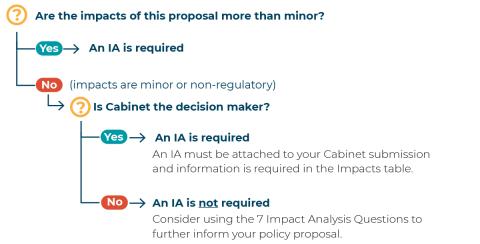The Government’s Impact Analysis Framework helps policymakers develop the evidence base for well-informed decision making. Almost every Government proposal being considered is within scope of the Government’s impact analysis requirements. The process and level of analysis required depends on the significance and impact of the proposal.
We are here to help at every stage of your policy development journey.
We will assess if the impacts are more than minor.
The assessment considers:
- What is the potential scale of the problem?
- What is the nature of the proposed options?
- How many stakeholders are affected?
- What is the impact on individuals, businesses, and community organisations?
- What are the potential cost burdens or savings?
- Who is the decision maker?
Note, an IA is required in some form for all Cabinet decisions – In-depth IA, Minor IA, or a short statement in the Impact table in the Cabinet submission.
Agencies provide information by completing the Preliminary Assessment form and submitting it to us. Alternatively, agencies may send us a version of their policy proposal.
Resources
Based on the information you provide, we will advise whether an IA is required, and if so, the depth of analysis required.

We will let you know within 5 working days whether you need to complete an IA.
We encourage you to stay in touch with us throughout the policy and IA development process.
An Early Assessment can be undertaken when you have completed the first 4 of the 7 Impact Analysis Questions and planned your consultation process. Submitting an IA for Early Assessment is optional but highly encouraged.
The Early Assessment considers:
- Whether the information provided is proportionate to the scale and scope of the proposal
- Whether the information is sufficient for consultation or major non-final decision, and
- Whether you have considered all policy options available.
Agency provides us with the IA covering the first 4 Impact Analysis Questions and a consultation plan.
The Final Assessment IA addresses the 7 Impact Analysis Questions and is signed off by your Deputy Secretary or equivalent delegate.
The Final Assessment must be completed before the final decision point or public announcement.
The Final Assessment is a 2-step process (First and Second Pass assessment).
An IA is assessed according to 4 assessment tiers:
- Exemplary practice.
- Good practice,
- Adequate, or
- Insufficient.
First Pass – Agency submits an IA covering all 7 Impact Analysis Questions.
First Pass – Within 5 business days, we will formally comment and advise on the quality of the analysis and process.
Second Pass – Agency updates the IA and resubmits the IA for final assessment.
Second Pass – Within 5 business days, we will provide our final assessment and the final IA is provided to the decision maker.
Following the public announcement of the policy or measure, the final IA (3c.) and our assessment (3d.) will be publicly released.
A PIR is required if any of the following criteria apply:
- We assessed the proposal as having a substantial or widespread economic impact,
- An IA was required and one was not done or was assessed as not meeting the Government’s impact analysis framework, or
- A Prime Minister’s exemption was granted from the requirement to complete an IA.
Resources
We will advise if a PIR is required.
Agency provides the PIR covering all 7 Impact Analysis Questions with a focus on how well the regulation is achieving its original objectives.
We will provide the final assessment and the PIR.